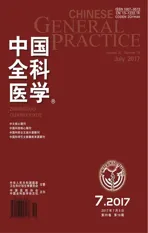《The Medical Republic》案例分享
——艾德娜女爵士,南瓜饼和一颗沉重的心
2017-07-12LeonPiterman黄振武黄文静
Leon Piterman,黄振武(译),黄文静(译),杨 辉(译)
·世界全科医学工作瞭望·

《The Medical Republic》案例分享
——艾德娜女爵士,南瓜饼和一颗沉重的心
Leon Piterman1,黄振武(译)2,黄文静(译)2,杨 辉(译)1
全科医生;心理问题躯体化表现;躯体形式障碍
PITERMAN L.艾德娜女爵士,南瓜饼和一颗沉重的心[J]. 黄振武,黄文静,杨辉,译.中国全科医学,2017,20(19):2303-2305.[www.chinagp.net]
PITERMAN L.Dame edna,pumpkin scones and a sinking heart[J]. HUANG Z W,HUANG W J,YANG H,translators.Chinese General Practice,2017,20(19):2303-2305.
他们可能会让我们心情沉重。但是如果懂得审视自我的话,那么治疗躯体化患者会让我们振奋起来。
1 伊迪斯的故事
在我第一次见到伊迪斯的时候,她已经快70岁了。我诊所的老同事正考虑退休,他认为自己有道德上的义务,将他的所有“麻烦患者”移交给我这个社区里的全科新人。
那时,伊迪斯是单身,且从未结过婚。她住在离诊所八千米远的地方,这就意味着她每个日常就诊都是一次火车旅行。几年后我发现,她来诊所就诊有一个鲜为人知的秘密,她的朋友米尔德就住在诊所附近的拐角处。米尔德也是我的患者,而伊迪斯和米尔德是多年的恋人。不过,如果让大家知道他们的关系,可能会被理解为不合时宜的、令人不自在的、没有必要的。但最重要的是,他们互相在意和关照,我想这对于他们才是胜过一切的东西。
我一直觉得伊迪斯在模仿Barry Humphries创作的喜剧人物艾德娜女爵士(Dame Edna Everidge)的言行举止。事实上,根据日历上的粗略计算,反过来说可能更接近事实,艾德娜女爵士很有可能抄袭了伊迪斯的举止和服饰。伊迪斯又高又瘦,常常戴着紫色或绿松石颜色的帽子或贝雷帽,配同样颜色的手套。戴着像鹰一样的眼镜,挎同样风格的手提包。穿高跟鞋,偶尔穿皮草时装。我觉得她打扮得像是晚上去剧场看演出,而不是周五下午出门去全科医生处就诊。她的鼻子总会扑厚厚的粉,两颊隐藏在胭脂下。她说话的声音高亢而刺耳,如果她有上过朗诵课,那她一定会在低级班就被淘汰。
伊迪斯的肠胃问题由来已久。她做过很多实验室检查,也去过很多次专家门诊,但都无法得到像教科书中一样的经典诊断。肠易激综合征是她的疾病标签,但各种干预措施都无法缓解她因此而带来的痛苦。伊迪斯总是把她的就诊时间定在周五的16:30,并且拒绝我每一次要把时间提早一点的建议。作为一名年轻的医生,我相对缺乏以患者为中心的服务经验,但我会认真倾听伊迪斯那种如诗如歌般的描述。食物如何从她的口腔一点点辗转到肛门,每一个肠道的蠕动和扭曲都是独特的挑战。我尝试从生理和心理上去解释她的症状,但结果却往往让她诉说出新的更多的不适,而且这种不适不能用已知的综合征去解释。通常情况下,30 min的看诊结束后,我会收到伊迪斯准备的一纸袋新鲜南瓜饼。但花费了这么长时间在她的胃肠系统旅行后,南瓜饼对我来说已经不那么具有诱惑力了。
于我而言,周五下午充满了恐惧。伊迪斯会在我的预约患者名单中吗?像她这样的患者是会频繁来就诊的,而且她非常有可能会锁定我16:30以后的门诊时间,然后再去和米尔德约会。我需要一个挣脱的办法,将她的就诊时间限制在15 min以内,以减轻我自身的肠道不适而不是她的,从而把我那颗搁浅的心给打捞出来。我想到了一个办法,那就是让接诊员在她就诊15 min后打电话,通知我去处理治疗室的紧急情况。这个招数貌似很奏效,不过经过4~5次这种精心策划的计划后,伊迪斯很有礼貌地问我:“医生,为什么你总是在周五下午的4点45分有急救?”。
在她面前我很失败和受挫,治疗方面也没有很好的办法。我仿佛被捆绑住,动弹不得,我的情绪也一点一点陷下去。后来我发现,这是我自己的问题。我需要从更深的层面去了解自己,以及我对伊迪斯的反应。之后,我钻研了Michael Balint博士的著作,学习心理问题躯体化表现(somatisation)和躯体形式障碍(somatoform disorder)的相关知识,这帮助我能够更好地处理像伊迪斯这样的患者。很遗憾我没有在初级医生时就学到Michael Balint博士的文章,否则我就会使用再归因的方法帮助患者理解病情,并让自己能够应对像伊迪斯这样的患者。
2 后记
“让人心沉的患者”(heart sink patient),是已故的Michael Balint博士总结出的术语。Michael Balint博士是一名在上世纪50年代与全科医生一起探讨看诊过程中的情感维度,以及面对困难患者时全科医生感受的精神病学专家。著有开创性的著作《The Doctor,his Patient and the Illness》,是遍布全球的巴林特小组(Balint Group)创始人。巴林特小组指定期探讨临床医生遇到的问题。
每位全科医生都会遇到许多“让人心沉的患者”,他们无处不在,症状难以诊断且痛苦更难以治疗。我们给这些患者贴上心理问题躯体化表现和躯体形式障碍的标签。然而,标签本身既不能让我们更容易地与他们建立起联系,也不能帮助他们明白自身痛苦可能是有心理因素的。
这些患者总会徘徊在医生周围,不会离开。他们反复地接受大量检查,但结果都是阴性;他们多次转诊至专科医生处,但依然坚信自身的一些“毛病”并未被诊断出来。他们和医生间无法达成协议。每次,当我和其他全科医生在预约名单上看到这些患者名字的时候,就会陷入绝望和沮丧的境地。就像有只蝴蝶在胃里翻腾一样,心里难受,心情低落。

译者注:艾德娜女爵士(Dame Edna Everidge)是澳大利亚喜剧男谐星Barry Humphries创造的家喻户晓的喜剧形象,男扮女装表演艾德娜夫人,是澳大利亚最成功、最知名、最受澳大利亚和英美各国喜爱的喜剧人物。他的形象是珠光宝气、搔首弄姿、华丽登场的贵妇,有时蔷薇紫、有时粉红、有时酒红的蓬松卷发,眼彩、红唇,艳丽夺目。标志性的还有镶满彩色宝石的飞檐鸾凤眼镜,身穿宫廷华服。嗓门极大,笑声极为夸张。Barry Humphries的成功让他获得了澳大利亚骑士勋章、英国表演界最高荣誉勋章CBE,墨尔本市中心的一条街道也因此更名为艾德娜路。
志谢:特别感谢原文出版者《The Medical Republic》同意将此文编译后刊登于《中国全科医学》。
They may make our hearts sink,but treating somatising patients can be uplifting if we learn to look within ourselves.
Edith was in her late 60s when I first met her.My senior partner in the practice was contemplating retirement and saw it as his moral duty to hand over all of his "troublesome patients" to me,the new boy on the block.
Edith was single and had never married.She lived about eight kilometers from the clinic,which meant a train journey to attend her regular visits.
It was only years later that I discovered that the ulterior motive for her visits to our patch was that her friend Mildred lived around the corner from the clinic.Mildred was also one of my patients.Edith and Mildred had been lovers for many years.It was unfashionable,uncomfortable,and perhaps unnecessary,for them to come out.Importantly,they cared for each other,and that is all that mattered.
I always felt that Edith had modelled her demeanor on that of Barry Humphries′ comic creation Dame Edna Everidge.In fact,based on rough calendar calculations,the converse may have been closer to the truth.Dame Edna may well have plagiarised Edith′s manner and haute couture.
She was tall and lean.Always wore a purple or turquoise hat or beret,matching gloves,eagle-like glasses,a matching handbag,high heels,and occasionally a fur.I felt she was dressed for a night at the theatre rather than a Friday afternoon outing to a suburban general practice.Her nose was always heavily powdered and her cheeks drowned in rouge.She spoke with a high-pitched,piercing voice.If she′d had elocution lessons then she must have missed the lower-register classes.
Edith had a long history of bowel problems.Numerous tests and specialist visits had failed to reach a classic text-book diagnosis.Irritable bowel was the label attached to her malady,and as is often the case,multiple interventions failed to alleviate her suffering.
Edith always scheduled her appointments for 4:30 on a Friday afternoon,thwarting any of my attempts for an early exit.As a young doctor relatively inexperienced in patient-centred care,I would listen to Edith describe,in almost poetic terms,the passage of food from her oral cavity to the anus.Each turn and twist of the gut provided its unique challenges.I tried to explain her symptoms in physiological and psychological terms only to be met with a further battery of ailments that defied any known syndrome.
At the end of these 30-minute consultations,I was usually presented with a paper bag of her freshly prepared pumpkin scones.Having spent a consultation travelling through the interstices of Edith′s bowels,the pumpkin scones were hardly an enticing delicacy.
Friday afternoons were filled with trepidation.Was Edith on my appointment list? Patients such as her were frequent attenders so the likelihood was always high that she would fill my 4:30 time slot,en route to Mildred.
I needed an escape strategy.Something that would enable me to terminate the consultation after 15 minutes,diminish the tension in my gut if not in hers and save my heart from sinking.I thought of a solution.I instructed my reception staff to call me after 15 minutes to attend an emergency in the treatment room.This seemed to work,however,after four or five such carefully planned emergencies,Edith politely asked:"Doctor,why is it that you always have an emergency at 4:45 on a Friday?"
I was lost and defeated.Therapeutically destitute,I was now trapped and emotionally bereft.
I discovered then and there that I was the problem.I needed to understand myself and my reaction to Edith at a deeper level.The discovery of Balint′s work,learning about the nature of somatisation and somatoform disorders,later helped me to manage Edith and many others like her.It is a pity I was not exposed to this literature as a junior doctor and to the role of reattribution in helping patients understand the disorder and in helping me cope with patients such as Edith.
Post script
The term "heart-sink" patient was coined by the late Dr Michael Balint,a psychiatrist who worked with GPs in the 1950s to explore the emotional dimensions of consultations and the feelings of GPs when confronted with difficult patients.
He subsequently wrote the seminal text,TheDoctor,hisPatientandtheIllness,and was the founding father of Balint groups now scattered all over the globe which meet regularly to explore the problems facing clinicians.
Every GP has a number of heart-sink patients.They are ubiquitous.Their symptoms are difficult to diagnose and even more difficult to treat.We use the terms somatisation and somatoform disorder to attach a label to these patients.The label itself does not make it easier to connect with them nor help them understand that there may be a psychological basis to their suffering.
These patients do not go away.After repeated multitudes of negative tests and specialist referrals they are still convinced that something has been missed.There is absence of agreement between physician and patient.
Each time I and other GPs see these patients on an appointment list we are thrown into a state of despair and frustration.The butterflies rise in the stomach.The heart sinks.
(本文编辑:王凤微)
Dame Edna,Pumpkin Scones and a Sinking Heart
General practitioners;Somatisation;Somatoform disorder
注:本文首次刊登于《The Medical Republic》
R 197 R 395.9
A
10.3969/j.issn.1007-9572.2017.19.002
2017-06-05)
【编者按】 澳大利亚的全科医生具有行业自律性,体现在其自行制定行业标准、自主进行资质考核及自主执业等方面,也体现在《The Medical Republic》这一共享平台上。Leon Piterman是医学学士,医学博士,教育学硕士,英国医生学会会员,澳大利亚全科医生学会会员,Monash University副校长、全科医学教授,从事全科医学临床服务近40年;研究兴趣为慢性病管理、心理健康、医学教育;曾获澳大利亚勋章,医学部医学教育奖,澳大利亚全科医生学会研究奖,香港全科医生学会研究奖等;获多项澳大利亚卫生和医学研究理事会等大型研究项目,发表科学文章和著作章节120余篇,《全科医学中的精神病学》合作著者。Leon Piterman教授建议我国的全科医生应培养“共和”思想,以为全科医学领域提供更多的平等交流机会。目前Piterman教授定期为《The Medical Republic》撰写文章,本刊深受“医学共和”思想的启发,特邀本刊编委Monash University杨辉教授对Piterman教授的文章进行编译,并进行连载刊登!本期Leon Piterman教授为我们讲述了一例“让人心沉的患者”(heart sink patient),该名词由Michael Balint博士总结得出。全科医生在接诊该类患者时往往感觉无奈和无力,像有块石头压在心头,影响了接诊情绪。临床中,这类患者往往会被贴上心理问题躯体化表现(somatisation)和躯体形式障碍(somatoform disorder)的标签,但单纯地贴上这种标签并无益于与患者的沟通和诊治。因此,Leon Piterman教授建议全科医生,应积极学习相关知识,以切实了解患者病情,提高自身接诊该类患者的能力,敬请关注!
1.3168 Monash University,Melbourne,Australia
2.518003 广东省深圳市,罗湖医院集团黄贝岭社区健康服务中心
